
- •Предисловие
- •Раздел 1. Семестровые задания по английскому языку
- •1 Семестр
- •2 Семестр
- •3 Семестр
- •4 Семестр
- •5 Семестр
- •Раздел 2. Методические указания по выполнению семестровых заданий
- •2.1 Работа с текстом и лексическим материалом
- •2.2. Контрольная работа
- •2.3. Устные темы
- •Раздел 3. Вводный фонетический курс
- •Фонетика Особенности английского произношения
- •Сводные таблицы правил чтения Четыре типа чтения английских гласных букв в ударных слогах
- •Чтение ударных сочетаний гласных букв
- •Согласные буквы, имеющие два чтения
- •Чтение сочетаний согласных букв
- •Раздел 4. Контрольные работы Контрольная работа №1
- •Вариант № 1
- •1. Переведите письменно текст
- •Вариант № 2
- •Контрольная работа №2
- •Вариант № 1
- •1. Переведите письменно текст
- •2. Дайте письменные ответы на следующие вопросы:
- •4. Укажите номера синонимичных пар слов
- •5. Переведите предложения на русский язык и определите видовременную форму сказуемого.
- •6. Переведите на русский язык, определите типы придаточных предложений.
- •Вариант № 2
- •1. Переведите письменно текст
- •2. Дайте письменные ответы на следующие вопросы:
- •4. Укажите номера синонимичных пар слов
- •5. Переведите предложения на русский язык и определите видовременную форму сказуемого.
- •6. Переведите на русский язык, определите типы придаточных предложений.
- •Раздел 5. Устные темы
- •Раздел 6. Учебные тексты
- •Раздел 7. Тексты для аудиторной работы
- •Глоссарий
- •Список использованной литературы
Раздел 6. Учебные тексты
Text 1
The History of Russian Fine Arts
(Part 1)
T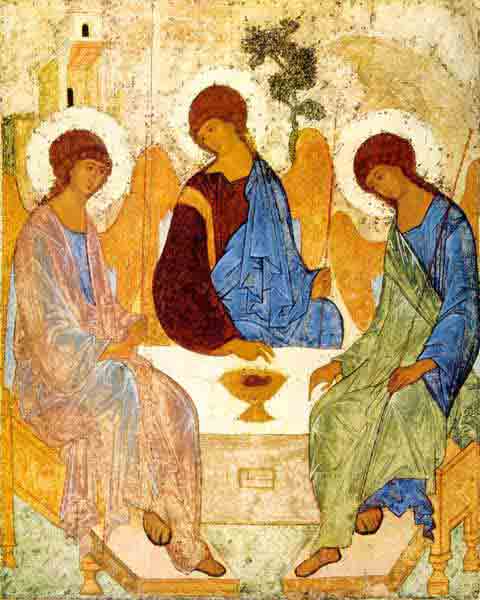 here
are two periods in the history of Russian fine arts. Peter the Great
reforms marked the border between them. The difference is rather deep
and concerns the very essence of artistic perception of the world and
a human being.
here
are two periods in the history of Russian fine arts. Peter the Great
reforms marked the border between them. The difference is rather deep
and concerns the very essence of artistic perception of the world and
a human being.
In Old Russia painting appeared and developed in a close connection with icon worshiping, the basis of which is the doctrine of Incarnation.
Alongside with Christianity the Russian masters adopted the Byzantium artistic style and technique developed through centuries.
The flourishing of Russian medieval painting refers to the 14th-15th centuries and it is reflected in the works of Pheophan Grek and Andrey Rublev. The top of Russian icon painting is Trinity (1422-1427) by A.Rublev, which he created as a symbol of spiritual consent and unity of Russian people.
Since the middle of the 16th century icon painting undergoes the influence of Western fine arts. Developed icon painting of the court school used Western European plot schemes. The end of the 16th century and the beginning of the 17th century is marked by the development of 'Stroganoff school' that is distinguished by the refinement of color and careful working at details and by the tendency to some decoration and 'prettiness' of painting.
The end of the 19th century is marked by awakening interest in an icon as 'a great world art' (E.Trubetskoy). Artistic principles of icon painting were used creatively by both single Russian icon-painters (V.Vasnetsov, M.Nesterov, K.Petrov-Vodkin), foreign ones (A.Matisse) and by the whole vanguard schools.
Words
essence ['es(ə)ns] – суть, смысл
concern [kən'sɜ:n] – касаться, затрагивать
artistic [ɑ:'tɪstɪk] perception [pə'sepʃ(ə)n] – художественное восприятие
icon worshiping – иконопочетание
the doctrine of Incarnation – доктрина о воплощении
adopt – перенимать, заимствовать
flourishing ['flʌrɪʃɪŋ] – период расцвета
spiritual ['spɪrɪtʃʋəl] consent [kən'sent] and unity – духовное согласие и единение
undergo – подвергаться, претерпевать
court school – придворная щкола
plot schemes [ski:mz] – эскизы
distinguish [dɪs'tɪŋgwɪʃ] – отличаться
refinement [rɪ'faɪnmət] of color – изящество цвета
careful working at details – тщательное прописывание деталей
vanguard ['vængɑ:d] schools – авангардистские школы
Text 2
The History of Russian Fine Arts
(Part 2)
In the 18th century and at the beginning if the 19th century fine arts in Russia, following cultural needs of the society, experiences all the main stages of Western art: Baroque, Classicism, Romanticism. Foreign painters and sculptors play an important role but very talented home masters appear in the time of Elisabeth I.
I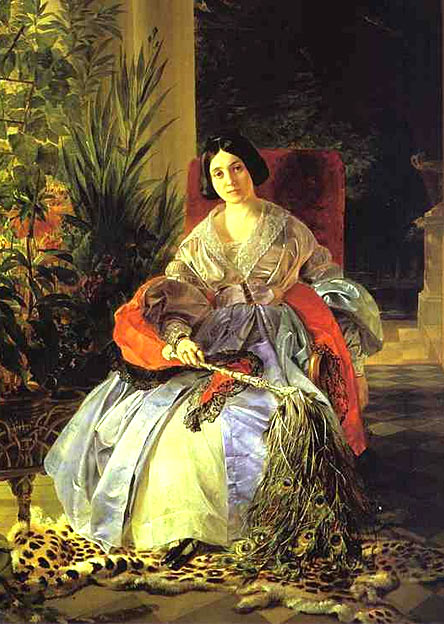 n
the middle of the 18th century academic manner becomes a leading
trend in painting. It is characterized by strict manner of painting,
by following certain rules in composition, by some conditional
character of coloring, by making use of the plots from the Bible,
from ancient history and mythology.
n
the middle of the 18th century academic manner becomes a leading
trend in painting. It is characterized by strict manner of painting,
by following certain rules in composition, by some conditional
character of coloring, by making use of the plots from the Bible,
from ancient history and mythology.
The flourishing of an academic school refers to the first half of the 19th century. K.Bryullov's canvas are characterized by the combination of academic Classicism with Romanticism, by novelty of plots, by the theatrical effect of plastic and lighting, by complex composition and by brilliant virtuosity of a painter's brush.
In 1860-1870s the painters showed their interest in the themes connected with people's life. In 1872 in contrast to the Academy of Arts the Association of traveling art exhibition is founded (I.Kramskoy, G.Myasoedov,K.Savitskiy, I.Pryanishnikov, V.Makovskiy, V.Perov, etc).
The appeal to national themes resulted in flourishing of historical and battle painting. V.Surikov, I.Repin, V.Vasnetsov, V.Vereschagin, F.Rubo created real masterpieces in those genres.
Having achieved independence in their creative activity since the end of the 19th century Russian painting follows the same European course of fine arts. Landscape painting is ousting genre painting. Striving for depicting air and light, peculiar to Impressionism, can also be found in the works of F.Vasilyev, I.Levitan, V.Serov, K.Korovin, and A.Arhipov. Symbolism, Neo-classicism and Modern influenced greatly A.Vrubel, the painters from 'World of Arts' (A.Benois, L.Bakst, E.Lansere) and the painters from 'A Blue Rose' (S.Sideikin, N.Krymov, V.Borisov-Musatov). The 1910s are marked by the appearance of Russian vanguard, as an aspiration to rebuild the very essence of art up to the denial of art itself. A number of artists and creative associations set new schools and new trends, which influenced radically the development of world's fine arts - Supermatism (K.Malevich), 'the style of improvisation' and abstract art (V.Kandinskiy).
The Renaissance of Russian vanguard is referred to 1960s. So-called 'allowed', but not the official part of Russian art of the 1960s is represented by the works of the masters of 'severe style' (T.Salakhov, S.Popkov).
Crash of Communism in the USSR destroyed artificial cultural barriers between Russia and the rest of the world. Nowadays Russian art is a welcome visitor almost on every part of the world. This inspires optimism as cross-cultural communication is a real sign showing the state of world's art.
Words
experience [ɪk'spɪ(ə)rɪəns] – пережить
academic manner – академизм
leading trend – ведущее направление
strict manner of painting – строгая манера прописи
conditional character of coloring – условный характер нанесения краски
novelty ['nɒveltɪ] – новизна
complex composition – сложная композиция
virtuosity [ˌvɜ:tʃʋ'ɒsɪtɪ] of a brush – виртуозное владение кистью
appeal [ə'pi:l] to – обращение к
oust [aʋst] – вытеснить, занять место
strive for – добиваться, стремиться добиться
depicting air and light – изображение воздуха и света
peculiar [pɪ'kju:lɪə] to – характерный для
denial [dɪ'na(ə)l] – отрицание
Text 3
Vasily Surikov
Vasiliy Surikov is an outstanding Russian master. The master’s works are in the same range as the masterpieces of Russian culture like “Boris Godunov” by A. Pushkin, “War and Peace” by L. Tolstoy, “Khovanshina” by M. Musorgsky.
Vasily Ivanovich Surikov was born in1848 in a Siberian town of Krasnoyarsk. In 1870 the talented youth came to Peterburg and entered the Academy of Arts.
Surikov’s first large painting, the “Morning of the Streltsy Execution” (1881), was devoted to the time of Peter the Great.
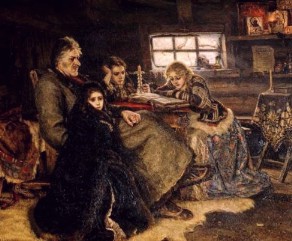 The
picture “Menshikov in Beryozov” (1883) was devoted to Alexander
Menshikov, the statesman at the time of Peter the Great. After the
Tsar’s death, Menshikov fell in disgrace and was dismissed from
all his posts and exiled to a remote part of Siberia. The picture
shows Menshikov with his family in a tiny log hut with a small
frozen window, old icons in the corner and and a icon-lamp in front
of them. In the centre of the picture is Prince Alexander Menshikov.
Next to him is his elder daughter Mary. The model for Mary had been
the painter’s wife. Colouristically, this picture is considered
the best work in the Russian painting of the XIX century.
The
picture “Menshikov in Beryozov” (1883) was devoted to Alexander
Menshikov, the statesman at the time of Peter the Great. After the
Tsar’s death, Menshikov fell in disgrace and was dismissed from
all his posts and exiled to a remote part of Siberia. The picture
shows Menshikov with his family in a tiny log hut with a small
frozen window, old icons in the corner and and a icon-lamp in front
of them. In the centre of the picture is Prince Alexander Menshikov.
Next to him is his elder daughter Mary. The model for Mary had been
the painter’s wife. Colouristically, this picture is considered
the best work in the Russian painting of the XIX century.
During 1884 – 1912 Surikov painted “Boyarinya Morozova”, “Yermak Conquering Siberia”, “Suvorov Crossing the Alps”, “Stepan Razin”, “Princess Visiting a Nunnery”.
Alongside the history pictures, the aster created many portraits, mostly the Siberian women, dressed in old Russian attires. He also made several interesting self-portraits and many exquisite watercolours.
Vasily Surikov died in 1916 in Moscow.
Words
outstanding master – великий художник, мастер
range - ряд
youth - юноша
enter - поступть
devoted - посвященный
statesman – государственный деятель
disgrace – немилость, опала
dismiss – увольнять, смещать
exile – ссылка, изгнание
remote – отдаленный, далекий
tiny – очень маленький, крошечный
log - бревно
hut – хибарка, изба
nunnery – женский монастырь
attire – наряд, платье
exquisite – изысканный, утонченный
Text 4
The History of English Art
(Part 1)
T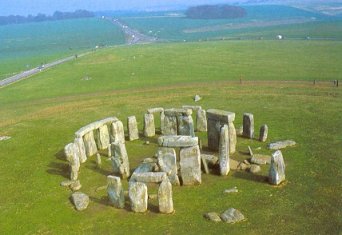 he
oldest art in England can be dated to the Neolithic period,
including the large ritual landscapes such as Stonehenge from
c. 2600 BC. From around 2150 BC, the Beaker peole learned how to
make bronze, and use both tin and gold. They became skilled in
metal refining and works of art placed in graves have survived. In
the Iron Age, a new art style arrived as Celtic culture spread
across the British isles. Though metalwork, especially gold
ornaments, was still important, stone and most likely wood was also
used. This style continued into the Roman period,
beginning in the 1st century BC, and would find a renaissance in
the Medieval period. The arrival of the Romans brought the
Classical style of which many monuments have survived, especially
funerary monuments, statues and busts. They also brought glasswork
and mosaics. In the 4th century, a new element was introduced
as the first Christian art was made in Britain. Several
mosaics with Christian symbols and pictures have been preserved.
he
oldest art in England can be dated to the Neolithic period,
including the large ritual landscapes such as Stonehenge from
c. 2600 BC. From around 2150 BC, the Beaker peole learned how to
make bronze, and use both tin and gold. They became skilled in
metal refining and works of art placed in graves have survived. In
the Iron Age, a new art style arrived as Celtic culture spread
across the British isles. Though metalwork, especially gold
ornaments, was still important, stone and most likely wood was also
used. This style continued into the Roman period,
beginning in the 1st century BC, and would find a renaissance in
the Medieval period. The arrival of the Romans brought the
Classical style of which many monuments have survived, especially
funerary monuments, statues and busts. They also brought glasswork
and mosaics. In the 4th century, a new element was introduced
as the first Christian art was made in Britain. Several
mosaics with Christian symbols and pictures have been preserved.
After Roman rule, the Anglo-Saxons brought Germanic traditions, seen in the metalwork of Sutton Hoo. Anglo-Saxon sculpture was outstanding for its time, at least in the small works in ivory or bone that are almost all that have survived. Anglo-Saxon art developed a very sophisticated variety of contemporary Continental styles. By the first half of the 11th century, English art was being lavishly patronized by the wealthy Anglo-Saxon elite, who valued above all works in precious metals, but the Norman Conquest in 1066 brought a sudden halt to this art boom, and instead works were melted down or removed to Normandy. After a pause of some decades, painting in England soon became again the equal of any in Europe. Some of the extremely rare survivals of English medieval panel paintings, like the Westminster Retable and Wilton Diptych are of the highest quality. Another art form introduced through the church was stained glass, which was also adopted for secular uses. There was a considerable industry producing Nottingham alabaster reliefs for mid-market altarpieces and small statues, which were exported across Northern Europe.
The artists of the Tudor court in the Renaissance and their successors until the early 18th century were mostly imported talents, often from Flanders. These included Hans Holbein the Younger, Van Dyck, Rubens, Orazio Gentileschi and others. An exception must be made for the portrait miniature, where a strong English tradition began with the Elizabethan Nicholas Hilliard, who had learnt from Continental artists, and continued with Isaac Oliver and many other artists. By the following century a number of significant English painters of full-size portraits began to emerge, and towards the end of the century the other great English specialism, of landscape painting, also began to be practiced by natives. Both were heavily influenced by Anthony Van Dyck in particular, although he does not seem to have trained any English painters himself, he was a powerful influence in promoting the baroque style.
Words:
metal refining – очистка металла
metalwork – художественная работа по металлу
bust [bʌst] – скульптурное поясное изображение, бюст
ivory ['aɪv(ə)rɪ] – слоновая кость
lavishly ['lævɪʃlɪ] – обильно, чрезмерно; щедро
melted down – расплавлять
panel painting – живописное панно
stained glass – витраж
secular ['sekjʋlə] – светский, мирской, нецерковный
alabaster ['æləbɑ:stə] – алебастр, гипс
altarpiece ['ɔ:ltəpi:s] – алтарь
successor [sək'sesə] – приемник, наследник
landscape – пейзаж
Text 5
The History of English Art
(Part 2)
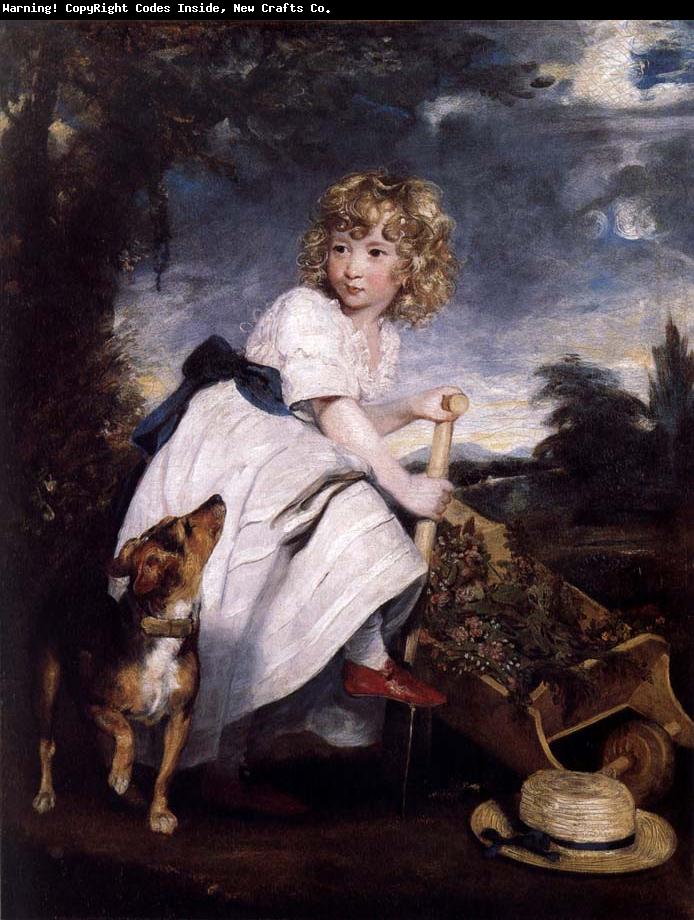 In
the 18th century, English painting finally developed a distinct
style and tradition again, still concentrating on portraits and
landscapes, but also attempting, without much success, to find an
approach to history painting, regarded as the highest of
the hierarchy of genres. Sir James Thornhill's paintings
were executed in the Baroque style of the
European Continent and William Hogarth reflected the
new English middle-class temperament — English in habits,
disposition, and temperament, as well as by birth.
His satirical works, full of black humour, point out
to contemporary society the deformities and weaknesses of London
life.
In
the 18th century, English painting finally developed a distinct
style and tradition again, still concentrating on portraits and
landscapes, but also attempting, without much success, to find an
approach to history painting, regarded as the highest of
the hierarchy of genres. Sir James Thornhill's paintings
were executed in the Baroque style of the
European Continent and William Hogarth reflected the
new English middle-class temperament — English in habits,
disposition, and temperament, as well as by birth.
His satirical works, full of black humour, point out
to contemporary society the deformities and weaknesses of London
life.
Portraits were, as elsewhere in Europe, much the most easiest and most profitable way for an artist to make a living, and the English tradition continued to draw of the relaxed elegance of the portrait style developed in England by Van Dyck, although there was little actual transmission from his work via his workshop.
Leading portraitists were Thomas Gainsborough; Sir Joshua Reynolds, founder of the Royal Academy of Arts. Joseph Wright of Derby was well known for his candlelight pictures, George Stubbs for his animal paintings. By the end of the century, the English swagger portrait was much admired abroad, and had largely ceased to look for inspiration abroad.
The early 19th century also saw the emergence of the Norwich school of painters. Influenced by Dutch landscape painting and the landscape of Norfolk, the Norwich School were the first provincial art-movement outside of London. Short-lived due to sparse patronage and internal faction prominent members include 'founding father' John Crome, John Sell Cotman notable for his water-colours in particular and the promising but short-lived maritime painter Joseph Stannard.
Paul Sandby was called the father of English watercolour painting. Other notable 18th and 19th-century landscape painters include Richard Wilson; George Morland; John Robert Cozens; John Constable; J. M. W. Turner; and John Linnell.
The Pre-Raphaelite movement, established in the 1840s, dominated English art in the second half of the 19th century. Its members — William Holman Hunt; Dante Gabriel Rossetti; John Everett Millais and others — concentrated on religious, literary, and genre works executed in a colorful and minutely detailed almost photographic style.
Words:
history painting – историческая живопись, картина на историческую тему
hierarchy ['haɪ(ə)rɑ:kɪ] – иерархия
genre ['ʒɑnrə] – жанр, вид, стиль
deformity [dɪ'fɔ:mɪtɪ] – порок, недостаток
to make a living – зарабатывать на жизнь
water-colour – акварельная краска
genre work – жанровая живопись
swagger portrait – парадный портрет
maritime painter – художник, пишущий морские пейзажи
landscape painter – художник-пейзажист
Text 6
Turner, John Mallord William (1775-1851)
One of the finest landscape artists was J.M.W. Turner, whose work was exhibited when he was still a teenager. His entire life was devoted to his art. Unlike many artists of his era, he was successful throughout his career.
Joseph Mallord William Turner was born in London, England, on April 23, 1775. His father was a barber. His mother died when he was very young. The boy received little schooling. His father taught him how to read, but this was the extent of his education except for the study of art. By the age of 13 he was making drawings at home and exhibiting them in his father's shop window for sale.
Turner was 15 years old when he received a rare honor--one of his paintings was exhibited at the Royal Academy. By the time he was 18 he had his own studio. Before he was 20 print sellers were eagerly buying his drawings for reproduction.
He quickly achieved a fine reputation and was elected an associate of the Royal Academy. In 1802, when he was only 27, Turner became a full member. He then began traveling widely in Europe.
V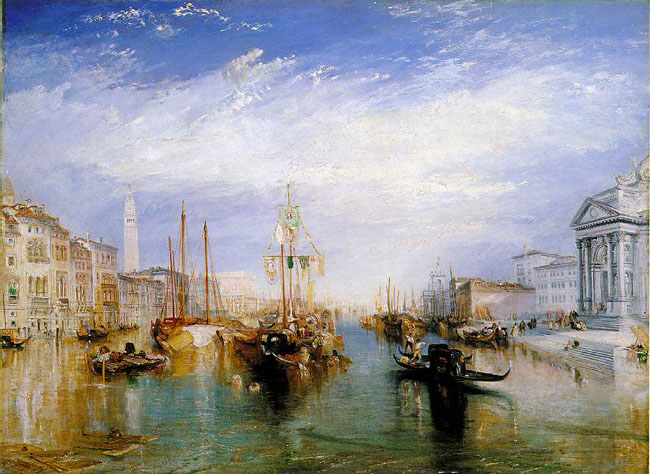 enice
was the inspiration of some of Turner's finest work. Wherever he
visited he studied the effects of sea and sky in every kind of
weather. His early training had been as a topographic draftsman.
With the years, however, he developed a painting technique all his
own. Instead of merely recording factually what he saw, Turner
translated scenes into a light-filled expression of his own romantic
feelings.
enice
was the inspiration of some of Turner's finest work. Wherever he
visited he studied the effects of sea and sky in every kind of
weather. His early training had been as a topographic draftsman.
With the years, however, he developed a painting technique all his
own. Instead of merely recording factually what he saw, Turner
translated scenes into a light-filled expression of his own romantic
feelings.
As he grew older Turner became an eccentric. Except for his father, with whom he lived for 30 years, he had no close friends. He allowed no one to watch him while he painted. He gave up attending the meetings of the academy. None of his acquaintances saw him for months at a time. Turner continued to travel but always alone. He still held exhibitions, but he usually refused to sell his paintings. When he was persuaded to sell one, he was dejected for days.
In 1850 he exhibited for the last time. One day Turner disappeared from his house. His housekeeper, after a search of many months, found him hiding in a house in Chelsea. He had been ill for a long time. He died the following day--Dec. 19, 1851.
Turner left a large fortune that he hoped would be used to support what he called "decaying artists." His collection of paintings was bequeathed to his country. At his request he was buried in St. Paul's Cathedral.
Although known for his oils, Turner is regarded as one of the founders of English watercolor landscape painting. Some of his most famous works are Calais Pier, Dido Building Carthage, Rain, Steam and Speed, Burial at Sea, and The Grand Canal, Venice.
Text 7
Open-air Art with a Spot of Realism
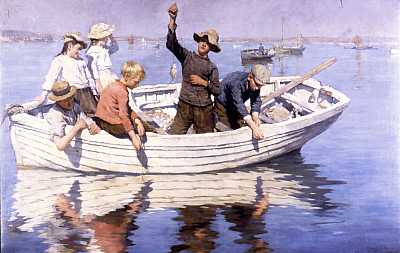 Newlyn
is the only working fishing port in England associated with artists
since 1880.
Newlyn
is the only working fishing port in England associated with artists
since 1880.
Although not the first artist to work in Newlyn, Stanhope Forbes is the most well-known and was called the “Farther of the Newlyn School”. It was he who said, ‘The Newlyners are followers of no one – simply a body of artists who paint in the open air.’
But he was no accurate in saying so. The Newlyn School, in those years, followed the idea of open-air painting as practiced by the French artist Jules Lepage.
Painting in the open air was a phenomenon of the 19th century. Its most celebrated exponent was Jean Francois Millet who pleasant life in Barbison. The Impressionists also painted directly from nature, but their approach to it was to analyze tone, light and colour as they affected surfaces rarther than to record reality. So it may be said that reality was ignored by open-air painting. Unfortunately, Lepage and his English follower George Clausen were only interested in landscape, painting the peasants as idyllic fixtures, the realty of rural poverty being rarely evident.
This is also true of the Newlyn School. True, there are many paintings of fishermen and women but the emphasis is on landscape and paintings of friends.
Romanticism combined with naturalism and a touch of realism made the Newlyn School successful later on, especially at the Royal Academy. However, there were exceptions. The Royal Academy rejected early Stanhope Forbes as representing a foreign influence, particularly his most famous painting “The Fish Sale on a Cornish Beach”.
But recently he has again been considered worthy of exhibition as a major British painter.
After becoming a Royal Academician in 1910 Forbes changed his emphasis from tone to colour and his figures became incidental to the landscape. Yet he still maintained his loyalty to painting from nature.
Apart from Forbes the most important Newlyn artist was a woman, Dod Proctor. Not because she recorded reality, which she did not, but for her handling of light and tone which gave her figures a solid three-dimensional reality.
Dame Laura Knight is also to be recommended. She moved to Newlyn from miners’ area, where she had painted some notable interiors of their homes. While being in the miners’ area she made her miner models, who were short of food and clothes.
The Newlyn School stood out due to its opposition to the idealized sentimentality of the Pre-Raphaelites, the leading school of painting in England in the 19th century, which was dealing with a romantic medieval past that never was. At any rate the Newlyn School, though not dealing with the complexities of reality, did at least begin with an observation of the external world, wich may free the artist from their artistic seclusion and bring them closer to reality.
Words:
accurate ['ækjəreit] – точный, достоверный
exponent [eks'pəʋnent] – представитель
approach [ə'prəʋtʃ] – подход
open-air painting – живопись на пленэре, пленэрная живопись
emphasis – акцент
incidental – эпизодический, случайный
handling of light and tone – владение светом и цветом
three-dimensional – трехмерный
seclusion – уединение, изоляция
Text 8
Pushkin State Museum of Fine Arts
O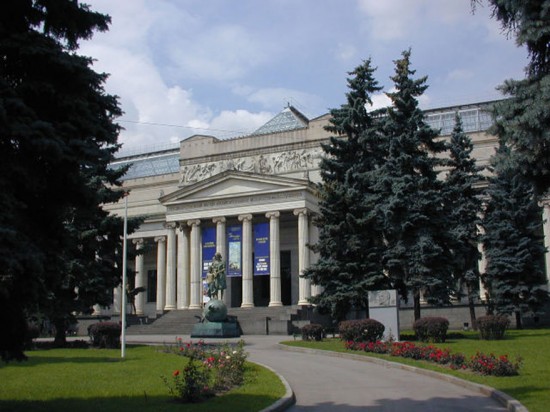 ne
of the richest world collections of fine arts from the time
immemorial to nowadays is treasured in the Pushkin State Museum of
Fine Arts that is favorably situated in the very center of Moscow,
close to the Kremlin and Red Square. Nowadays it is the second,
after the Hermitage in Saint Petersburg, largest museum of foreign
art in Russia.
ne
of the richest world collections of fine arts from the time
immemorial to nowadays is treasured in the Pushkin State Museum of
Fine Arts that is favorably situated in the very center of Moscow,
close to the Kremlin and Red Square. Nowadays it is the second,
after the Hermitage in Saint Petersburg, largest museum of foreign
art in Russia.
The Museum originates from the Cabinet of Fine Arts and Antiquities, established in the 1840s on the initiative of professors and scientists of the Moscow University. Wonderful collections of the Cabinet formed the basis of the exposition of the new Museum of Fine Arts. For the construction of the museum’s building the territory of the former Carriage (Kolymazni) court that is in the very center of the city not far from the Kremlin was given by Moscow Duma to the University. The winner of the architectural contest and the author of the project was Roman Ivanovich Klein. He designed the building that reminds greatly of an ancient classical temple on the high podium with the Ionic colonnade along the facade. Its splendid interiors were decorated according to the styles of certain historical periods that were to be represented there.
The solemn opening of the Museum that at first was officially called the Museum of Fine Arts named after Alexander III took place on May 31, 1912.
According to the conception worked out by the first director of the Museum, professor of Moscow University, Doctor of Philology and Art Historian Ivan Tsvetaev (the father of famous Russian poet Marina Tsvetaeva) the museum collection was enlarged with the plaster casts of world-famous works of arts treasured in different museums of Europe. Thus the new museum was planned as a depository of copies of famous pictures.
After the Revolution of 1917 the Museum was nationalized and its collection was greatly enriched by paintings from expropriated private collections, nationalized Moscow estates and abolished museums and galleries. In the course of the 20th century the Museum changed its name more than once. The establishment was given its present name – the Pushkin State Museum of Fine Arts – in 1937.
Nowadays there are over 560,000 works of art exhibited in the halls of the Pushkin State Museum of Fine Arts. The museum treasures Egyptian mummies, antique amphorae and craters with images of Greek and Roman gods and heroes, old steles and sarcophagi, paintings by Rembrandt, Botichelli, Canaletto, Guardi, Tiepolo, impressive collection of Little Dutch Masters, impressionists, postimpressionists and modernists and many other works that form the gold collection of world art heritage. In the last few years the Museum got several new premises that render possible exhibiting of many private collections that for many years stayed inaccessible for the public.
Text 9
T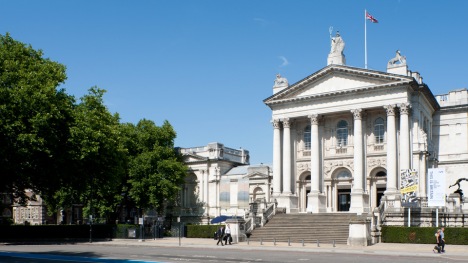 he
Tate Gallery
he
Tate Gallery
The Tate is an institution that houses the United Kingdom's national collection of British Art, and International Modern and Contemporary Art. It is a network of four art museums: Tate Britain, London (previously known as the Tate Gallery, founded 1897), Tate Liverpool (founded 1988), Tate St Ives,Cornwall (founded 1993) and Tate Modern, London (founded 2000), with a complementary website, Tate Online (created 1998). There are plans to open a TATE in Southampton in 2020. It is an executive non-departmental public body of the Department for Culture, Media and Sport.
Tate is used as the operating name for the corporate body which was established by the Museums and Galleries Act 1992 as The Board of Trustees of the Tate Gallery.
The gallery was founded in 1897, as the National Gallery of British Art. When its role was changed to include the national collection of Modern Art as well as the national collection of British art, in 1932, it was renamed the Tate Gallery after sugar magnate Henry Tate of Tate & Lyle, who had laid the foundations for the collection. The Tate Gallery was housed in the current building occupied by Tate Britain which is situated in Millbank, London. In 2000, the Tate Gallery transformed itself into the current-day Tate, or the Tate Modern, which consists of a federation of four museums: Tate Britain which displays the collection of British art from 1500 to the present day; Tate Modern which is also in London, houses the Tate's collection of British and International Modern and Contemporary Art from 1900 to the present day. Tate Liverpool, in Liverpool has the same purpose as Tate Modern but on a smaller scale, and Tate St Ives displays Modern and Contemporary Art by artists who have connections with the area. All four museums share the Tate Collection. One of the Tate's most publicised art events is the awarding of the annual Turner Prize, which takes place at Tate Britain.
Text 10
The Guggenheim
T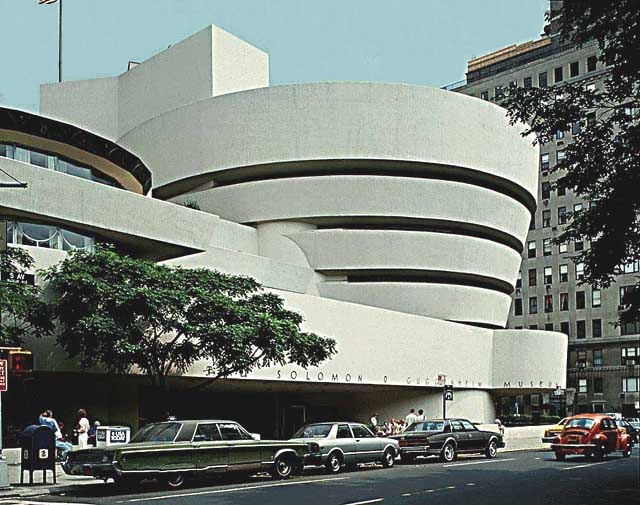 he Solomon
R. Guggenheim Museum (often
referred to as "The
Guggenheim") is a well-known art museum located on the Upper
East Sideof Manhattan in New
York City.
It is the permanent home of a renowned and continuously expanding
collection of Impressionist, Post-Impressionist,
early Modern and contemporary
art and
also features special exhibitions throughout the year. The museum
was established by the Solomon
R. Guggenheim Foundation in
1939 as the Museum of Non-Objective Painting, under the guidance of
its first director, the artist Hilla
von Rebay.
It adopted its current name after the death of its founder, Solomon
R. Guggenheim,
in 1952.
he Solomon
R. Guggenheim Museum (often
referred to as "The
Guggenheim") is a well-known art museum located on the Upper
East Sideof Manhattan in New
York City.
It is the permanent home of a renowned and continuously expanding
collection of Impressionist, Post-Impressionist,
early Modern and contemporary
art and
also features special exhibitions throughout the year. The museum
was established by the Solomon
R. Guggenheim Foundation in
1939 as the Museum of Non-Objective Painting, under the guidance of
its first director, the artist Hilla
von Rebay.
It adopted its current name after the death of its founder, Solomon
R. Guggenheim,
in 1952.
Designed by Frank Lloyd Wright, the cylindrical museum building, wider at the top than the bottom, was conceived as a "temple of the spirit" and is one of the 20th century's most important architectural landmarks. The building opened on October 21, 1959, replacing rented spaces used by the museum since its founding. Its unique ramp gallery extends from just under the skylight in the ceiling in a long, continuous spiral along the outer edges of the building until it reaches the ground level. The building underwent extensive expansion and renovations from 1992 to 1993 (when an adjoining tower was built) and from 2005 to 2008. The museum's collection has grown organically, over eight decades, and is founded upon several important private collections, beginning with Solomon R. Guggenheim's original collection. The collection is shared with the museum's sister museums in Bilbao, Spain, and elsewhere.
Text 11
Vincent Van Gogh (1853 – 1890)
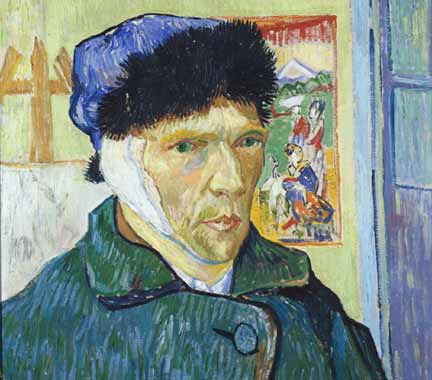 Van
Gogh is today one of the most popular of
the Post-Impressionist painters,
although he was not widely appreciated during his lifetime.
Nobody has ever painted corn-fields or sunflowers like Van Gogh. His
paintings are full of colour and sunlight. Today his painting are
worth millions of pounds but in his lifetime he sold only one.
Van
Gogh is today one of the most popular of
the Post-Impressionist painters,
although he was not widely appreciated during his lifetime.
Nobody has ever painted corn-fields or sunflowers like Van Gogh. His
paintings are full of colour and sunlight. Today his painting are
worth millions of pounds but in his lifetime he sold only one.
Van Gogh was born in Holland in 1853. He did not start painting until he was twenty-seven, ten years before he died. Before becoming a painter, he was a teacher, an art dealer and a church preacher.
In 1886 he left Holland and joined his yanger brother, Theo, who was working in Paris at that time. After living there for two years, he moved to the warmer climate of Arles in the south of France. Here he painted some of his most famous pictures.
However, Van Gogh was mentally ill. During one of his fits of madness he attacked his friend, the artist Paul Gauguin. In another fit of madness, Van Gogh cut off part of his own ear. Eventually he went into a mental hospital but he did not get any better.
Finnaly, on Sunday 27th July 1890, in the small village of Auvers, north of Paris, Vincent Van Gogh took a gun, wnt into the a corn-field and shot himself. When his brother Theo arrived, he said ‘I hope I did it properly.’ Thirty-six hours later Van Gogh died in his brother’s arms. His last words were ‘La tristesse durera.’ (The sadness will continue.)
Words:
corn-field ['kɔ:nfi:ld] – поле, нива
sunflower ['sʌnflaʋə] – подсолнух
preacher ['pri:tʃə] – проповедник
mentally ['mentəlɪ] - умственно
Text 13
Sunflowers (1888) Vincent van Gogh
Fine Art Commentary
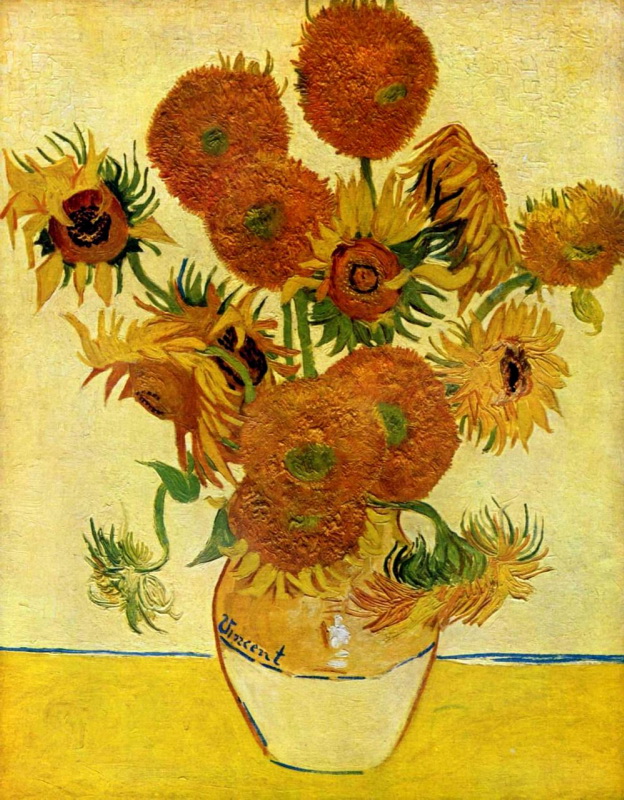 This
is one of four paintings of sunflowers dating from August and
September 1888. Van Gogh intended to decorate Gauguin's
room with these paintings in the so-called Yellow House that he
rented in Arles in the South of France. He and Gauguin worked there
together between October and December 1888.
This
is one of four paintings of sunflowers dating from August and
September 1888. Van Gogh intended to decorate Gauguin's
room with these paintings in the so-called Yellow House that he
rented in Arles in the South of France. He and Gauguin worked there
together between October and December 1888.
Van Gogh wrote to his brother Theo in August 1888, 'I am hard at it, painting with the enthusiasm of a Marseillais eating bouillabaisse, which won't surprise you when you know that what I'm at is the painting of some sunflowers. If I carry out this idea there will be a dozen panels. So the whole thing will be a symphony in blue and yellow. I am working at it every morning from sunrise on, for the flowers fade so quickly. I am now on the fourth picture of sunflowers. This fourth one is a bunch of 14 flowers ... it gives a singular effect.'
The dying flowers are built up with thick brushstrokes (impasto). The impasto evokes the texture of the seed-heads. Van Gogh produced a replica of this painting in January 1889, and perhaps another one later in the year. The various versions and replicas remain much debated among Van Gogh scholars.
Words:
bouillabaisse [ˌbu:jə'bes] – буйабес, уха по-марсельски
brushstroke ['brʌʃstrəʋk] – мазок кистью, манера класть мазки
impasto [ɪm'pæstəʋ] – импасто (прием письма); краска, наложенная густым слоем
evoke [ɪ'vəʋk] – пробуждать (чувства); вызывать (воспоминание, восхищение)
texture ['tekstʃə] – текстура изображения; воспроизведение текстуры, структуры изображаемого предмета
replica ['replɪkə] – точная копия, репродукция
Text 14
Pablo Picasso
Pablo Picasso was bom in Spain in 1881 and lived for 91 years. For most of his life he lived in Paris, France. When he died his mansion was turned into Museum Picasso, where his art can be seen today.
P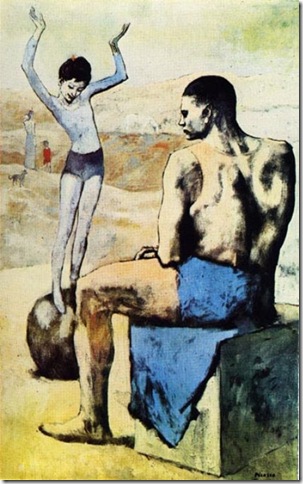 eople
say Picasso could draw before he could walk, with two well known
paintings being achieved at the ages of 9 and 13. When Picasso was a
child, pictures by Vincent Van Gogh and Paul Cezanne were the modem
masterpieces. These paintings looked nothing like real life.
eople
say Picasso could draw before he could walk, with two well known
paintings being achieved at the ages of 9 and 13. When Picasso was a
child, pictures by Vincent Van Gogh and Paul Cezanne were the modem
masterpieces. These paintings looked nothing like real life.
With Picasso's fantastic imagination he took those ideas even further. He started to paint about what he knew about the object or person. Anything solid was broken down into flattened, cut out 'pieces' so you could see all around it. The pieces were shaped like patterns, or cubes, so the new style was called 'Cubism'. When cubism first appeared some critics said it was a complete disaster. Some still do, though the style was Picasso's first gift to the art world. He didn't stop there.
Picasso once said that "a head has an eye, nose, ear and mouth and you can put them anywhere in a picture but the head remains a head". The exciting thing about Picasso was that he kept developing new styles, constantly switching between them.
It is impossible to label his work for one simple reason — Picasso was a genius in just the same way that Mozart magically composed music. Style didn't bother him and he painted and sculptured in any way he wanted. A few years after his cubism period he painted a portrait of his wife, Olga, a Russian ballerina in a peaceful and calm way.
Unlike many other artists Picasso wasn't poor. He had been successful nearly all his life and so had plenty of money. He lived in an elegant flat in a fashionable Paris street.
Picasso constantly tried out new forms of art and invented a new style which, strangely, remained a secret for most of his life — his sculptures. What made them so new and different was that he built them rather than carved them. He loved animals and built sculptures of them from materials he found just lying around, often in rubbish heaps.
One of Picasso's most striking animal sculptures grew out of the handle bars and saddle of an old bike. He found them by chance and decided they were in fact a bull's head. It is even more powerful because Picasso made it during the second World War when Paris was occupied by the Nazi German Army. The Bull is said to be like a menacing enemy.
The Soles (1940) Pablo Picasso
Fine Art Commentary
'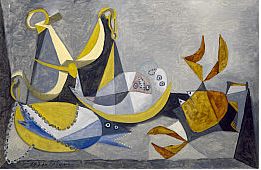 The
Soles' was painted in Paris in March 1940, but was inspired by the
town of Royan, on the Atlantic coast. Picasso was based in Royan at
the time and became homesick for the town, with its bustling
marketplace, during a three-month trip to Paris. The painting has
traditionally been called 'The Soles' but the fish in the scales on
the left is not a sole and the crab is perhaps the most dominant
element in the composition. It has been composed so that the claws
of the crab balance the shape of the scales. The crab also
represents Picasso himself, weighing up the qualities of his two
very different mistresses, Marie-Thérèse Walter (the rounded fish
in the centre) and Dora Maar, who appears as the aggressive,
sharp-faced fish. Both women were in Royan in 1940.
The
Soles' was painted in Paris in March 1940, but was inspired by the
town of Royan, on the Atlantic coast. Picasso was based in Royan at
the time and became homesick for the town, with its bustling
marketplace, during a three-month trip to Paris. The painting has
traditionally been called 'The Soles' but the fish in the scales on
the left is not a sole and the crab is perhaps the most dominant
element in the composition. It has been composed so that the claws
of the crab balance the shape of the scales. The crab also
represents Picasso himself, weighing up the qualities of his two
very different mistresses, Marie-Thérèse Walter (the rounded fish
in the centre) and Dora Maar, who appears as the aggressive,
sharp-faced fish. Both women were in Royan in 1940.
